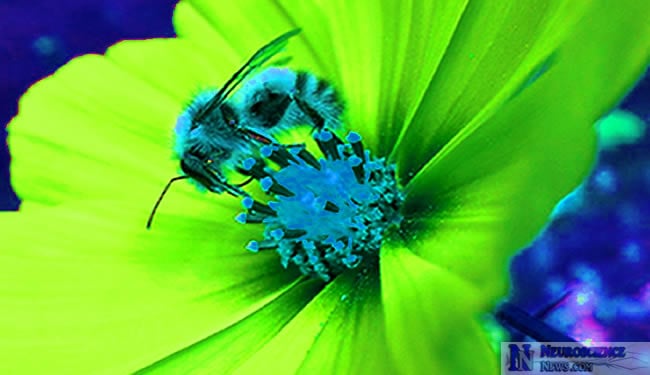A database on what colors flowers appear to be viewed as by bees has been collected and is freely searchable. The data is collected in the Floral Reflectance Database also known as FReD. Learn more about how bees see colors and FReD in the article below.
FReD can help explain how a bee sees!
Bees can see colours but they perceive the world differently to us, including variations in hue that we cannot ourselves distinguish.
Researchers at Queen Mary, University of London and Imperial College London have developed FReD – the Floral Reflectance Database – which holds data on what colours flowers appear to be, to bees. The development of the catalogue, which has involved a collaborative effort between researchers at two Schools at Queen Mary is reported in the journal PLoS ONE.
The work addresses the existing issue that records of flower colours do not take the visual systems of pollinator insects into account. Bees – for example – have evolved completely different colour detection mechanisms to humans, and can see colours outside our own capabilities in the ultra-violet range. Professor Lars Chittka from Queen Mary’s School of Biological and Chemical Sciences said: “This research highlights that the world we see is not the physical or the ‘real’ world – different animals have very different senses, depending on the environment the animals operate in.”
Professor Chittka and his team have measured the spectral reflectance of a number of flowers in different locations and analysed what bumblebees perceive, including different shades of ultra-violet. The image above shows a photograph of a creeping Zinnia (Sanvitalia procumbens) using a UV filter, giving just one example of the colours that are ‘hidden’ to us. Queen Mary PhD student Sarah Arnold, who is funded by the Biotechnology and Biological Sciences Research Council (BBSRC), was also involved with the project, she said: “We have created a database in which the colours of flowers are indexed from this vitally important pollinator’s point of view. For the first time, this database will allow us to analyse global trends in flower colour, for example how flower colours might change in areas with high UV radiation. There are many possible applications for scientists from different fields.”
Co-author Professor Vincent Savolainen, from the Department of Life Sciences at Imperial College London, who holds a joint post at the Royal Botanic Gardens, Kew, adds: “We hope this work can help biologists understand how plants have evolved in different habitats – from biodiversity hotspots in South Africa to the cold habitats of northern Europe. FReD’s global records may show how flower colour could have changed over time, and how this relates to the different insects that pollinate them, and other factors in their local environment.”
Samia Faruq from the School of Electronic Engineering and Computer Science is assisting Professor Chittka on an EPSRC funded PhD studentship, and is an expert in the computer modelling side of the project: “FReD provides over 2000 records with the colours that the bee sees presented in a very simple way. A successful flower has to be ‘noticed’ by the bee, and FReD provides a better understanding of the strategy flowers attain.
“Colour patterns emerging from the location or altitude in which flowers are found may in turn increase our understanding of the plant-pollinator relationship. We will also be able to determine if flower colours in a given location are converging or diverging in order to give themselves the best chance of reproducing.”
Professor Peter McOwan, a computer scientist who helped in developing the technical side of the project, commented: “This combination of biology and computer science, allowing scientist to collaboratively access important data in new ways shows the power of combining these two scientific disciplines. This interdisciplinary approach can produce significant new applications that will help make a real impact in better understand the natural world.”
The database is freely searchable and open for international contribution, and will inform future ecological studies. “The records can be used to link flowers together by colour, although they appear different to us. On a global scale we will be able to identify the colours preferred by pollinators and see how this varies. This is very significant in terms of the global food supply, which relies on these insects and bees in particular” added Professor Chittka.
Contact: James Lush – Queen Mary, University of London
Source: Queen Mary, University of London









